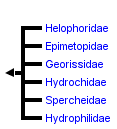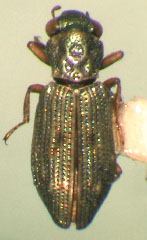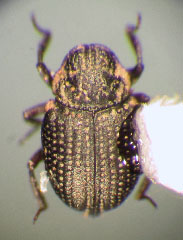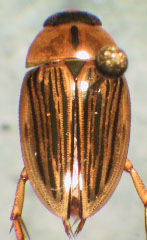Hydrophiloidea
Water scavenger beetles
Andrew Short


This tree diagram shows the relationships between several groups of organisms.
The root of the current tree connects the organisms featured in this tree to their containing group and the rest of the Tree of Life. The basal branching point in the tree represents the ancestor of the other groups in the tree. This ancestor diversified over time into several descendent subgroups, which are represented as internal nodes and terminal taxa to the right.

You can click on the root to travel down the Tree of Life all the way to the root of all Life, and you can click on the names of descendent subgroups to travel up the Tree of Life all the way to individual species.
For more information on ToL tree formatting, please see Interpreting the Tree or Classification. To learn more about phylogenetic trees, please visit our Phylogenetic Biology pages.
close boxIntroduction
The superfamily Hydrophiloidea (the water scavenger beetles) represents one of the most ecologically and morphologically diverse groups of Coleoptera with more than 3200 species broadly distributed in all biogeographic regions except Antarctica (Short & Hebauer 2006). As its name implies, a large proportion of hydrophiloids are aquatic. However, the group’s habits are in reality highly varied. While many live in ‘traditional’ freshwater habitats, such as ponds and stream margins, many occupy more specialized aquatic situations such as waterfalls (e.g. Oocyclus and allies), subterranean streams (e.g. Troglochares) and the water tanks of bromeliads (e.g. Phaenonotum). Other lineages have diversified in a staggering array of terrestrial niches: many are generalists of decaying vegetation or dung (e.g. Sphaeridium); some Oosternum are myrmecophilous; Tormissus is restricted to penguin guano, and several genera are even found in flowers. Although most larval hydrophilids occupy the same ecological niche as the imago, they are predaceous compared to the detritivore or algal-feeding adults.
Discussion of Phylogenetic Relationships
Constitution and higher-level relationships of the Hydrophiloidea
The first (and only) comprehensive analysis of the Hydrophiloidea using cladistic methods was undertaken by Hansen (1991). Based primarily on adult morphology, the resulting classification (here after, the “Hansen Classification”) has been widely adopted by nearly all aquatic Coleoptera systematists and further codified in a world catalogue of species (Hansen 1999). The increased accessibility to literature and testable hypotheses made possible by Hansen’s landmark works reinvigorated interest in the phylogeny of this frequently neglected group. The early history and views on the (pre-Hansen) classification of the Hydrophiloidea have been reviewed in detail by Hansen (1991, 1995). The intervening dozen years have seen more than ten subsequent papers addressing the interrelationships within lineages of Hydrophiloidea. Among these are the first works incorporating molecular data to infer the phylogeny.
Table 1. Summary of recent phylogenetic studies involving relationships within the Hydrophiloidea. Abbreviations: A, Adults; I, Immatures.
| Study | Data Type | Focal Taxon |
|---|---|---|
| Hansen, 1991 | Morphology (A & I) | Hydrophiloidea |
| Beutel, 1994 | Morphology (A & I) | Hydrophiloidea |
| Bameul, 1994 | Morphology (A) | Omicrini |
| Bameul, 1997 | Morphology (A) | Protosternini |
| Archangelsky, 1998 | Morphology (A & I) | Hydrophiloidea |
| Beutel, 1999 | Morphology (I: Head) | Hydrophiloidea |
| Archangelsky, 2004 | Morphology (A & I) | Hydrophilinae |
| Korte et al., 2004 | Molecular (2 genes) | Hydrophiloidea |
| Anton & Beutel, 2004 | Morphology (A: head) | Hydrophiloidea |
| Beutel & Komarek, 2004 | Morphology (A: thorax) | Hydrophiloidea |
| Beutel & Leschen, 2005 | Morphology (A & I) | Staphyliniformia |
| Bernhard et al., 2006 | Molecular (6 genes) | Hydrophiloidea |
| Komarek & Beutel, 2007 | Morphology (A) | Anacaenin |
Despite this plethora of studies involving both morphological and molecular data, the branching pattern among hydrophiloid families remains controversial. A summary of recent cladograms would result in an entirely unresolved strict consensus tree. Interestingly, despite the generation of numerous morphological and molecular datasets, none have been combined into a total-evidence framework. Consequently, each hypothesis is based on a particular character subset such as head structure (e.g., Beutel 1994, Anton & Beutel 2004), thoracic structure (Beutel & Komarek 2004), DNA sequence data (e.g., Bernhard et al. 2006), and larval data (Archangelsky 1998).
Placement of the Hydraenidae
The subfamilial placement of the Hydraenidae has, at certain times, been controversial. Originally a subgroup of Hydrophilidae, the lineage was later considered a distinct family of Hydrophiloidea (e.g., d’Orchymont 1916, Crowson 1950) and then as a family of the Staphylinoidea (e.g., Hansen 1991). Although the latter view has been generally accepted, it was recently challenged by Beutel (1994) who favored the former based on considerations of adult and larval head capsule structure. Recent morphological and molecular evidence uniformly supports the more accepted placement of the family Hydraenidae within the Staphylinoidea rather than the Hydrophiloidea (e.g., Korte et al. 2004, Beutel & Leschen 2005).
Nomenclature
Hydrophiloidea (s. l.) vs. Hydrophiloidea (s. str.)
The classification outlined here follows the Hydrophiloidea (s. str.) approach, which was standardized by Hansen (1991, 1995, 1999). Under the Hansen Classification, the term Hydrophiloidea excludes the Histeroidea, and the group is composed of 6 families. Although this classification is used in nearly all contemporary works (including all thirteen phylogenetic studies mentioned above!), there remains some residual use of “Hydrophiloidea (s. l.).”, in which the Hydrophiloidea encompasses the Histeroidea, and each of the six families of Hydrophiloidea (s. str.) is afforded subfamily status. To be sure, these two viewpoints are phylogenetically congruent, and differ only on ranks and circumscription. While the Hydrophiloidea (s. str.) approach is widely used and accepted by nearly all aquatic beetle authorities, a small number of publications still utilize Hydrophiloidea (s. l.) (e.g. American Beetles, see Van Tassell, 2001).
References
Anton, E. & Beutel, R.G. 2004. On the head morphology and systematic position of Helophorus (Coleoptera: Hydrophiloidea: Helophoridae). Zoologischer Anzeiger 242: 313–346.
Archangelsky, M. 1998. Phylogeny of Hydrophiloidea using characters from adult and preimaginal stages. Systematic Entomology 23:9-24.
Archangelsky, M. 2004. Higher-level phylogeny of Hydrophilinae (Coleoptera: Hydrophilidae) based on larval, pupal, and adult characters. Systematic Entomology 29: 188–214.
Archangelsky, M., Beutel, R.G., & Komarek, A. 2005. 10.1 Hydrophiloidea. Pp. 158-183. In R.G. Beutel & Leschen, R.A.B. Handbuch der Zoologie, Coleoptera, Beetles Vol. 1. Walter de Gruyter, Berlin.
Bameul, F. 1994. New Oriental Oreomicrus Malcolm (Coleoptera: Hydrophilidae: Sphaeridiinae) with a redefinition of the genus and notes on its phylogenetic relationships. Annales de la Société entomologique de France 30: 79–91.
Bameul, F. 1997. A revision of Mucetum d’Orchymont and Rhombosternum Balfour-Browne (Coleoptera: Hydrophilidae) with a phylogenetic analysis of Protosternini. Annales de la Société entomologique de France 33: 375–403.
Bernhard, D., Schmidt, C., Korte, A., Fritzsch, G., & Beutel, R.G. 2006. From terrestrial to aquatic habitats and back again – molecular insights into the evolution and phylogeny of Hydrophiloidea (Coleoptera) using multigene analyses. Zoologica Scripta 35: 597–606.
Beutel, R. G. 1994. Phylogenetic analysis of Hydrophiloidea based on characters of the head of adults and larvae. Koleopterologische Rundschau 64:103-131.
Beutel, R. G. 1999. Morphology and evolution of the larval head of Hydrophiloidea and Histeroidea. Tijdschrift voor Entomologie 142:9-30.
Beutel, R.G. & Komarek, A. 2004. Comparative study of thoracic structures of adults of Hydrophiloidea and Histeroidea with phylogenetic implications (Coleoptera, Polyphaga). Organisms Diversity and Evolution 4: 1–34.
Beutel, R.G. & Leschen, R.A.B. 2005. Phylogenetic analysis of Staphyliniformia (Coleoptera) based on characters of larvae and adults. Systematic Entomology 30: 510–548.
Hansen, M. 1991. The hydrophiloid beetles. Phylogeny, classification and a revision of the genera. Biologiske Skrifter 40:1-368.
Hansen, M. 1995. Evolution and classification of the Hydrophiloidea - A systematic review. Pages 321-353 in Biology, Phylogeny, and Classification of the Coleoptera: Papers Celebrating the 80th Birthday of Roy A. Crowson (J. Pakaluk, and S. A. Slipinski, eds.). Muzeum i Instytut Zoologii PAN, Warsaw.
Hansen, M. 1999. World Catalogue of Insects 2: Hydrophiloidea (Coleoptera). Stenstrup, Apollo Books, 416 pp.
Komarek, A. & Beutel, R.G. 2007. Phylogenetic analysis of Anacaenini (Coleoptera: Hydrophilidae: Hydrophilinae) based on morphological characters of adults. Systematic Entomology, DOI: 10.1111/j.1365-3113.2006.00359.x.
Korte, A., Ribera, I., Beutel, R.G., and Bernhard, D. 2004. Interrelationships of Staphyliniform groups inferred form 18S and 28S rDNA sequences, with special emphasis on Hydrophiloidea (Coleoptera, Staphyliniformia). Journal of Zoological Systematics and Evolutionary Research 42: 281–288.
Short, A.E.Z. & Hebauer, F. 2006. World Catalogue of Hydrophiloidea— additions and corrections, 1 (1999–2005) (Coleoptera) Koleopterologische Rundschau 76: 315–359.
Van Tassell, E. R. 2001. Hydrophilidae. pp. 187-208 in Arnett, R.H., Jr., and M. C. Thomas. (eds.). American Beetles. Volume 1. Archostemata, Myxophaga, Adephaga, Polyphaga: Staphyliniformia. CRC Press LLC, Boca Raton, FL. xvi + 443 pp.
Title Illustrations

| Scientific Name | Hydrochus |
|---|---|
| Specimen Condition | Dead Specimen |
| Image Use |
 This media file is licensed under the Creative Commons Attribution-ShareAlike License - Version 3.0. This media file is licensed under the Creative Commons Attribution-ShareAlike License - Version 3.0.
|
| Copyright |
© 2002

|
| Scientific Name | Epimetopus |
|---|---|
| Specimen Condition | Dead Specimen |
| Image Use |
 This media file is licensed under the Creative Commons Attribution-ShareAlike License - Version 3.0. This media file is licensed under the Creative Commons Attribution-ShareAlike License - Version 3.0.
|
| Copyright |
© 2002

|
| Scientific Name | Tropisternus |
|---|---|
| Specimen Condition | Dead Specimen |
| Image Use |
 This media file is licensed under the Creative Commons Attribution-ShareAlike License - Version 3.0. This media file is licensed under the Creative Commons Attribution-ShareAlike License - Version 3.0.
|
| Copyright |
© 2002

|
About This Page
Andrew Short

University of Kansas, Lawrence, Kansas, USA
Correspondence regarding this page should be directed to Andrew Short at
Page copyright © 2007 Andrew Short
 Page: Tree of Life
Hydrophiloidea. Water scavenger beetles.
Authored by
Andrew Short.
The TEXT of this page is licensed under the
Creative Commons Attribution License - Version 3.0. Note that images and other media
featured on this page are each governed by their own license, and they may or may not be available
for reuse. Click on an image or a media link to access the media data window, which provides the
relevant licensing information. For the general terms and conditions of ToL material reuse and
redistribution, please see the Tree of Life Copyright
Policies.
Page: Tree of Life
Hydrophiloidea. Water scavenger beetles.
Authored by
Andrew Short.
The TEXT of this page is licensed under the
Creative Commons Attribution License - Version 3.0. Note that images and other media
featured on this page are each governed by their own license, and they may or may not be available
for reuse. Click on an image or a media link to access the media data window, which provides the
relevant licensing information. For the general terms and conditions of ToL material reuse and
redistribution, please see the Tree of Life Copyright
Policies.
- Content changed 29 June 2007
Citing this page:
Short, Andrew. 2007. Hydrophiloidea. Water scavenger beetles. Version 29 June 2007 (under construction). http://tolweb.org/Hydrophiloidea/9224/2007.06.29 in The Tree of Life Web Project, http://tolweb.org/











 Go to quick links
Go to quick search
Go to navigation for this section of the ToL site
Go to detailed links for the ToL site
Go to quick links
Go to quick search
Go to navigation for this section of the ToL site
Go to detailed links for the ToL site